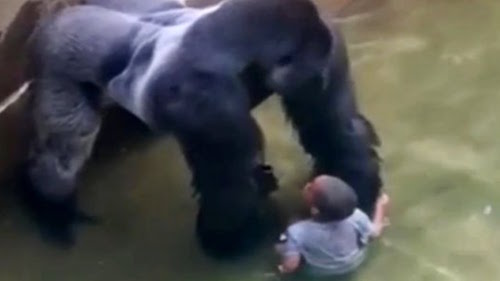 Culture & Ethics
Culture & Ethics
 Faith & Science
Faith & Science
 Intelligent Design
Intelligent Design
Responding to Animal Deaths, and What That Says About Humans

Can it really be true that we are still talking about Harambe the gorilla, who died on May 28? Yet in the June 27 Weekly Standard, our colleague Wesley Smith makes profound points about the events last month at the Cincinnati Zoo that perhaps could only become clear with the passage of some time and the perspective that brings.
There’s no question that we respond to deaths, animal and human, based on an unfathomable emotional logic:
We saw the same kind of outrage when an American killed Cecil the lion in Zimbabwe last year. Unlike Harambe’s, Cecil’s death was anything but a necessity — he was lured out of a sanctuary to be shot by a trophy hunter. But the howling after the hunter stupidly posted on Facebook his photo taken with the dead lion caused some to worry that people care more about slain animals than they do slain people.
Adding fuel to that cultural concern, many commenters noted that while Americans mourned Harambe, scores of people were shot and some killed — including children — in the war zone that has become Chicago. Where was the grief over those deaths? Others noticed that American media poured far more effort and emotion into reporting on the dead gorilla than they did on ISIS’s beheading of Christians in Libya last year — six times more coverage on major television networks, NewsBusters found. Pro-lifers, meanwhile, contrasted the outrage over Harambe with the ho-hum reaction of much of society to the million-plus abortions in the country each year.
What gives? Do most people really believe the deaths of a gorilla and lion matter more than the deaths of human beings?
I don’t believe it.
The outpouring of feeling for Harambe has no single explanation, but many. Wesley writes:
[W]e live in a time in which people “feel” more than they “think.” There is also the nature of the particular animals killed, which gets us back to the idea that the aesthetics involved in a killing can influence our emotional reaction to it. Harambe and Cecil were both magnificent creatures. Had either been, say, a warthog, I doubt we would have witnessed the same passionate outpouring. The emotional power of projected innocence may also explain the potent force that can be unleashed in the cases of animal deaths. Harambe was said to be protecting the child when shot.
Besides, Americans love animals. We coddle and coo over our cats and dogs as if they were human children. We place “Save the Whales” bumper stickers on our cars. We flock to national parks to catch fleeting glimpses of bear, elk, and antelope, remnants of the wild America that once was and yet still is. We fictionalize and anthropomorphize the animal world with movies like Bambi and Babe. We want our cheese to come from “happy cows.” For many of us, that sense of wonder about animals never leaves us, sparking anger and sadness when one is killed needlessly or wantonly.
This doesn’t mean that those who feel an animal’s death so deeply care less about humans who are killed. Or put another way, people don’t seem relatively indifferent to the fate of Christian martyrs and murdered Chicagoans because they care about the gorilla more. Rather, it is a defense mechanism. (Abortion is another story.) If we really let ourselves grieve for all the horrible and unjust human deaths that take place in the world every day, we would never get out of bed.
I thought at the time of the zoo shooting that some commenters were losing sight of the response to a gorilla as a product of design, whose death, however unavoidable, was a loss to the beauty of the world that in turn points to a transcendent purpose behind it all. But Wesley offers other insights that hadn’t occurred to me.
Innocence is part of it — that of the boy who fell into the enclosure, as Wesley says, and whose hand the gorilla seemed to hold in a protective way, but of Harambe himself. Animals are signifiers of innocence — certain animals more than others, of course. No offense to warthogs.
We call these animals “cute,” which is an interesting choice of words. How can an adult elephant tipping the scales at 15,000 pounds be “cute” — the same adjective we apply to a human baby? What do the two have in common? I remember asking the writer Wendy Shalit this years ago, and she put her finger on it: It’s the quality of innocence, which is precious and increasingly uncommon in our world.
True, too, we sentimentalize certain lives, and certain deaths, as we disregard others. Sometimes the explanation that leaps immediately to mind is a cynical one.
Wesley’s final point is especially enlightening. Some mourning is probably a kind of deflection or safety valve that allows us to go on without absorbing the full burden of suffering that occurs all around us.
For sure, there’s no algorithm behind which tragedies push our buttons and which don’t. Animals are far more predictable in what drives them. The incredible, bottomless complexity of our emotions is yet another aspect of what makes humans exceptional.
Image: Harambe the gorilla, via YouTube.
